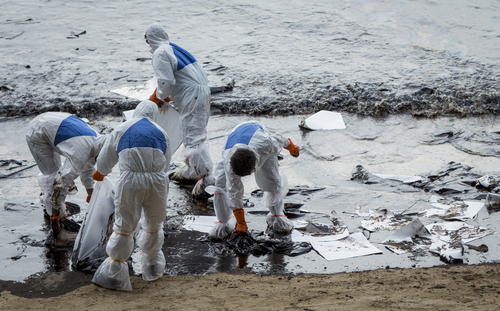 |
Oil spills to waters are subject to many different environmental factors such as wind, weather, waves, and temperature that influence which methods can be used the quickest with the highest level of success. In the United States, mechanical cleanup technologies are used most often, but dispersing agents and biological agents are also available.
Dispersing agents or “dispersants” are chemicals that break down the oil and separate it into tiny droplets that are then naturally dispersed in the water column where they are further dispersed by wind, waves, and currents. While dispersants do not immediately remove oil from the water, the dispersed oil droplets are eventually degraded by microorganisms and bacteria in the water column. Unfortunately, chemical dispersants may also be toxic, although testing by the Environmental Protection Agency (EPA) during the BP Gulf of Mexico oil spill showed dispersants “are generally much less harmful than the highly toxic oil leaking from the source and biodegrade in a much shorter time span.”
Simplify SPCC compliance with the NEW TRAC360 platform. In just a few minutes, see how easy it is to create compliant plans and checklists, train your team, and find answers to all your SPCC questions. Learn More.
If considering the use of dispersants, several additional factors also come into play, including:
- Dispersants work best when applied immediately following a spill;
- Dispersants work best at salinity levels near that of normal seawater; and
- Dispersants work best in warm water, although they can work in cold water.
Biological agents are used to increase the rate of natural biodegradation. These include microorganisms, nutrients, and enzymes that break down complex compounds such as oil for energy and nutrients. Left alone in the environment, oil will biodegrade over long periods of time; however, when shoreline and wetland habitats are threatened, time is of the essence so biological agents can be used to speed things up. This bioremediation tactic is often implemented after all mechanical methods have been used to recover the majority of the spilled oil.
In the United States, there are two bioremediation methods used for oil spill cleanup:
1) Biostimulation is when nutrients (e.g., phosphorus or nitrogen) are added to encourage the growth of microorganisms that then use the oil as a food source and naturally break it down into simple compounds; and
2) Bioaugmentation is the addition of microorganisms to the existing microorganism present. This is called “seeding” and is intended to have the same outcome as biostimulation; that is, more oil-loving microorganisms available to break down the oil. This practice, however, is not often used because the microorganisms that digest oil occur naturally almost everywhere.
The Ultimate SPCC Compliance Tool
TRAC360 for SPCC is a powerful application that simplifies compliance with EPA’s Spill Prevention, Control, and Countermeasure rule. Whether you need help creating your facility-specific SPCC plan, writing inspection checklists for your tanks, or training your oil-handling workforce, TRAC360 is there to help. Learn More.
The largest use of bioremediation occurred in response to the Exxon Valdez oil spill in 1989. Two days after the spill, a storm in Prince William Sound with 50-mile-per-hour winds washed much of the oil onto shorelines making them the primary focus of the cleanup effort. From 1989 to 1991, 107,000 pounds of nitrogen in fertilizers was applied to the impacted shorelines. In 1992, a survey showed that most of the oil had been removed and the remaining oil was left to degrade naturally.
One final alternative method of oil spill cleanup is called in-situ (on-site) burning and is essentially the controlled burn of an oil slick on water or on land. In-situ burning must be approved by the regional response team with jurisdiction and is usually used in conjunction with mechanical oil recovery equipment such as booms. This method is used more often on land than on water in the United States and has several implications, including air pollution, danger to required personnel from the intense heat, and the potential for the oil to go deeper into the ground as a result of the burning. Considerations for deploying in-situ burning also include proximity to human populations (minimum of 3 miles away for land spills), soil type, water level, potential for erosion, and vegetation and wildlife species present.
